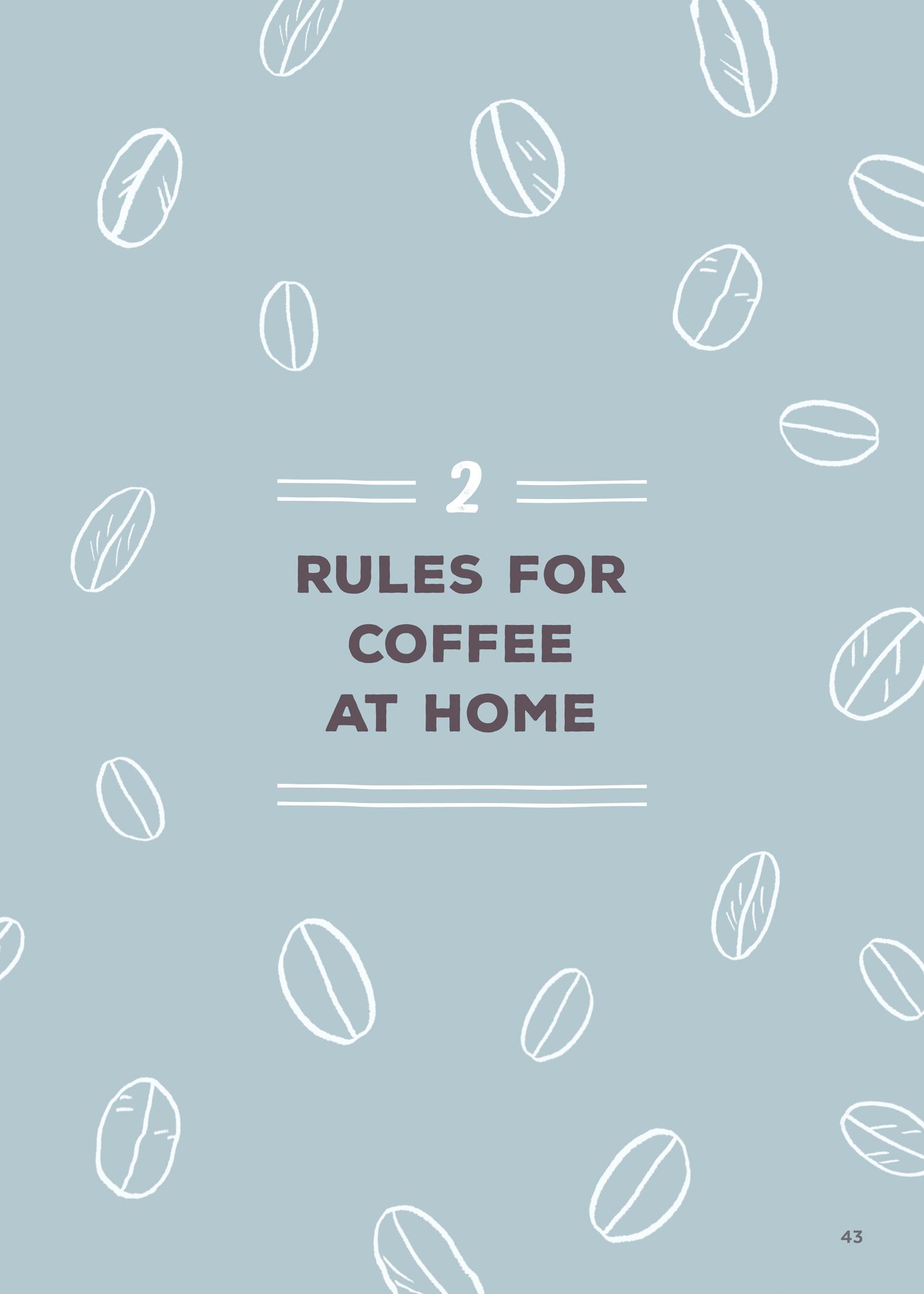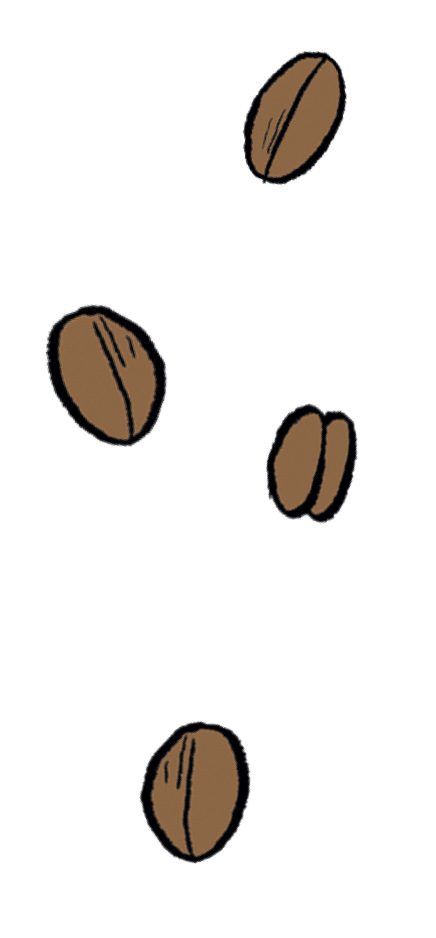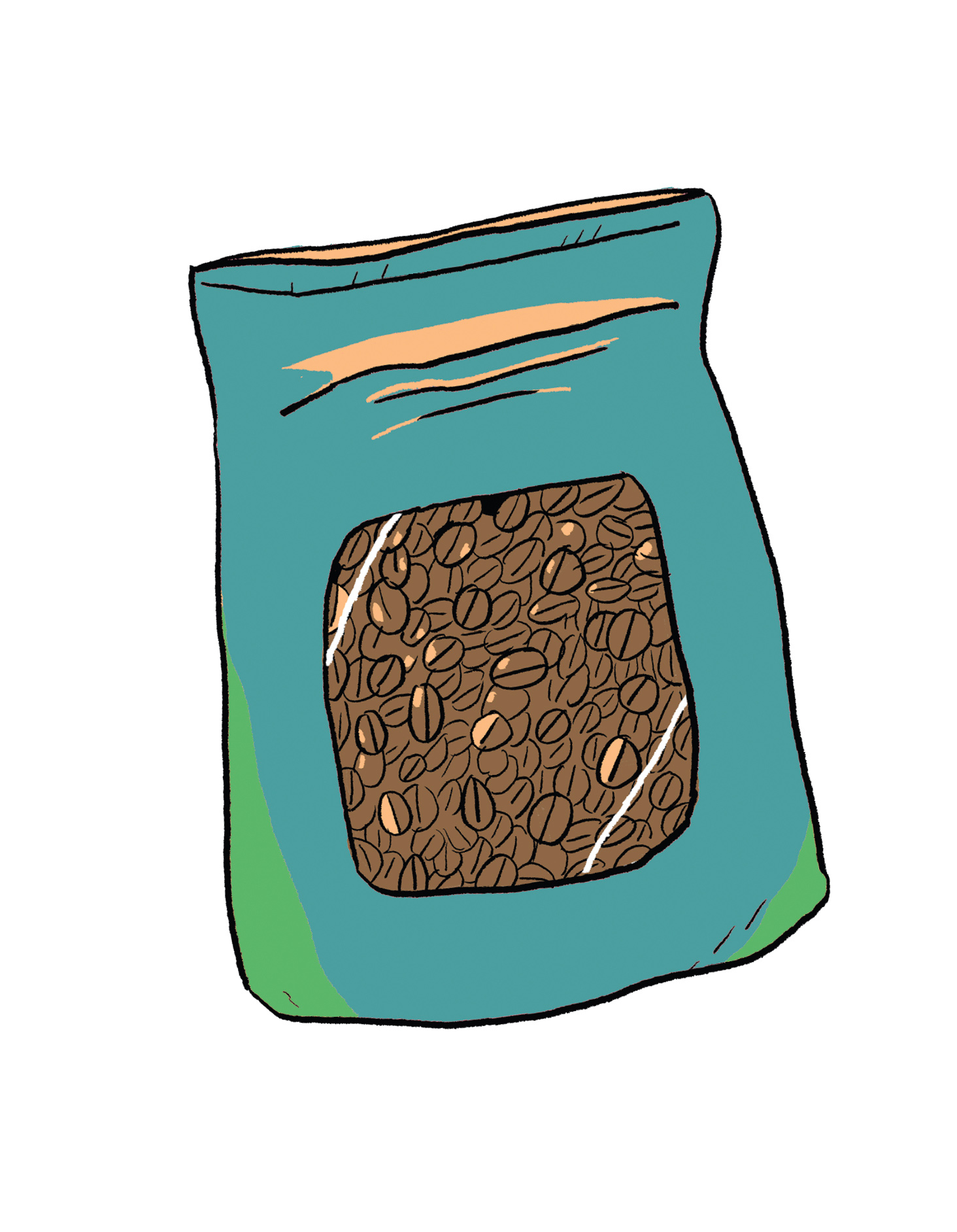
2 | Rules for Coffee At Home
RULE 11
You don’t need fancy gear to brew great coffee at home.

Good, fresh coffee costs anywhere between $12 and $25 a bag.
It’s true, and hallelujah. To brew delicious coffee at home, you pretty much just need some version of the following four things.

GOOD, FRESH COFFEE. This part is totally up to your tastes—some people like dark-roasted, strong-tasting coffees, while others prefer coffees that highlight varietal and terroir characteristics, resulting in a lighter, sweeter cup. Make sure it’s fresh (see Rule 17)! This is a huge part of making sure your brew tastes good. Decent, fresh coffee costs anywhere between $12 and $25 for a twelve ounce bag, which, considering it was grown by artisans on the other side of the planet, shipped by careful stewards across vast oceans, then roasted by another set of artisans wherever you might live, ought to seem like a steal.
A GRINDER. You’ll need this because, yes, you’ll be buying whole beans and grinding them yourself. This is key to making your coffee taste good, which is our goal, as opposed to buying preground coffee, which quickly goes stale and tastes bad. More specifically, buy a grinder that uses burrs—two small pieces of abrasive metal, set at an adjustable distance, that crush the coffee beans as they pass between them—rather than one with blades that cut up the beans. Blade grinders look kind of like a minuscule food processor—you may already be using one as a spice grinder. You can spend many hundreds of dollars on a nice electric burr grinder, or you can go with an entry-level option—the Baratza Encore retails for just above $100. If cost is an issue, you could opt to pick up a hand grinder like the Hario Mini Mill, which works just fine and costs around $30. (A nice bonus: hand grinders are small and portable and travel well on vacations, camping trips, or visits to Mom’s house.)

A BREWING APPARATUS. This is pretty much about personal preference—we to love to batch-brew filter coffee (the electric coffee maker we all know and love) at home, because we’re busy writing this book for you and don’t want to individually brew each cup. Bonavita makes a totally fine 5-cup brewer for around $100—this brewer will evenly disperse temperature-stable water across your brew bed using a preset brewing time, and you can adjust your recipe by choosing how much water or coffee to add. Bonavita’s home brewer is functional, but in our opinion, it’s not especially beautiful. If aesthetics are important for your home kitchen gear, you might opt instead for a more attractive brewer from brands like Technivorm or Ratio. Both of these brands offer brewers that will evenly disperse temperature-stable water across your brew bed using a preset brewing time, just like the Bonavita—the major difference is that they’ll look good doing it. Technivorm offers its Moccamaster home brewer in a rainbow of colors (one of this book’s coauthors owns a Moccamaster in Millennial Pink). The Ratio offers a forest of different wood finishes, including exotic options like brazilwood. If you decide to go the hand-brewed route, basic brew cones from brands like Hario and Melitta start at around $10, while the AeroPress brew plunger is around $30. A beautiful Chemex is more like $50 (it also doubles as a nice wine decanter and flower vase). We’ll cover the pros and cons of automatic versus manual brewing later in the book, in Rules 23 and 24.
HOT WATER. Water science vis-à-vis coffee is a hot topic in the higher levels of coffee nerdery, but it stands to figure that, just as milk affects a mocha, the water you use to brew a cup of coffee will affect its flavor. Buying filtered water (or using a home filter such as Soma or Brita) is a fine place to start; if you want to go further, brands like Third Wave Water are developing capsules specifically designed for coffee brewing. You’ll also need a way to heat up water. If you’re using a home batch brewer, that step is covered by the wonders of automation. If you’re hand brewing, of course the teakettle you already own and love is a fine place to start, but a specifically designed pouring kettle like those made by Hario, Takahiro, or Brewista reinforces good technique and hence, makes better coffee. These pouring kettles—called gooseneck kettles, after their distinctive spout shape—start at around $30. Worst-case scenario? You can always heat up water in the microwave, but you sacrifice a lot of control this way and can easily end up with water that’s too hot or too cold.


Coffee 201: The Science of Brewing
You can pour moderately hot water over any ol’ coffee grounds and call what comes out coffee. But we don’t think you should. Making a great (or even a serviceable!) cup of coffee involves a lot of science, and the interaction between the coffee and the water can be affected by a lot of tiny variables.
Water temperature is important. Standard industry practice dictates that water temperature should fall between 195°F and 205°F. Water hotter than that can produce a bitter cup; cooler water can underextract the coffee. Avoid using water just off the boil (too hot!).
The quality of the water is just as important. You’re looking for an acceptable range of calcium hardness, alkalinity, pH, sodium, and total dissolved solids. Some shops sell gallons of water with this ideal recipe. A company called Third Wave Water (see this page) sells capsules that treat distilled water, creating what they claim is the perfect water for coffee brewing.
The chemical makeup of tap waters around the world vary widely—this is thought to be why bread tastes great in San Francisco, pizza is the best in New York City, and coffee brews so readily in Seattle. Coffee scientists have figured out a workaround by treating water using reverse osmosis and mineral additions, to create a molecular composition that plays best with the chemical compounds in coffee. But if you don’t want to put on your pocket protector before your first cup of morning joe, just stick with filtered water and thank us later.
How you grind the coffee is a third factor. Burrs make for more evenly formed coffee particles, resulting in a more consistent extraction—if particle sizes aren’t uniform, some will overextract while others will underextract. Overextraction leads to bitter coffee. Under-extraction leads to sour coffee. It’s like putting different sizes of cookies in the oven: some might overcook, while others will undercook. An even approach is best.
Timing is everything. In pour-over methods, the contact time of water and coffee is controlled by gravity. If the coffee is too coarse, water will flow through it quickly, and the brew will be thin. If it’s too fine, the water will be in contact with the coffee for too long, resulting in a bitter cup. There is no universally accepted grind size for home brewing—it’s one of the most important variables in the whole process and can be frustrating. Trial and error is the only way to make sure you’re doing it right, and small adjustments can make a big difference.
